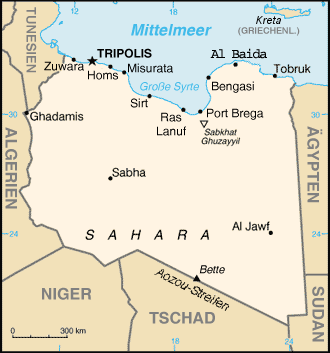This article needs to be updated.(July 2015) |










This is a list of the 100 largest populated places in Libya . Some places in the list could be considered suburbs or neighborhoods of some large cities in the list, so this list is not definitive.
Contents
| No. | City | Population |
|---|---|---|
| 1 | Tripoli / طرابلس الغرب | 1,317,009 [1] |
| 2 | Benghazi / بنغازي | 821,787 [1] |
| 3 | Misrata / مصراتة | 391,167 (2022) |
| 4 | Bayda / البيضاء | 245,518 [2] |
| 5 | Zawiya / الزاوية | 234,000 |
| 6 | Gharyan / غريان | 187,000 |
| 7 | Tobruk / طبرق | 172,500 |
| 8 | Ajdabiya / اجدابيا | 160,200 |
| 9 | Zliten / زليتن | 350,000 [3] |
| 10 | Derna / درنة | 150,000 [1] |
| 11 | Sirte / سرت | 128,123 |
| 12 | Sabha / سبها | 103,743 |
| 13 | Khoms / الخمس | 88,317 |
| 14 | Bani Walid / بني وليد | 85,425 |
| 15 | Sabratha / صبراتة | 80,000 |
| 16 | Zuwara / زوارة | 75,893 |
| 17 | Kufra / الكفرة | 68,940 |
| 18 | Marj / المرج | 62,894 |
| 19 | Tocra / توكرة | 60,681 |
| 20 | Tarhuna / ترهونة | 50,715 |
| 21 | Msallata / مسلاتة | 46,169 |
| 22 | Jumayl / الجميل | 39,344 |
| 23 | Sorman / صرمان | 36,707 |
| 24 | Al Gseibat | 32,559 |
| 25 | Shahhat / شحات | 28,818 |
| 26 | Ubari / أوباري | 27,796 |
| 27 | Asbi'a / الأصابعة | 27,693 |
| 28 | Jadid | 27,503 |
| 29 | Waddan / ودان | 27,000 |
| 30 | El Agheila / العقيلة | 26,813 |
| 31 | Abyar / الأبيار | 26,600 |
| 32 | Nofaliya / النوفلية | 25,997 |
| 33 | Regdalin / رقدالين | 25,831 |
| 34 | Gasr Akhyar | 25,261 |
| 35 | Al Qubah / القبة | 24,631 |
| 36 | Tawergha / تاورغاء * | 24,223 |
| 37 | Al Maya | 23,222 |
| 38 | Murzuk / مرزق | 22,395 |
| 39 | Brega | 21,715 |
| 40 | Teghsat | 21,642 |
| 41 | Hun | 19,816 |
| 42 | Jalu | 18,873 |
| 43 | Ajaylat | 18,277 |
| 44 | Nalut | 17,146 |
| 45 | Suluq | 16,999 |
| 46 | Shuhada' al Buerat | 16,282 |
| 47 | Zaltan | 15,801 |
| 48 | Mizda | 13,809 |
| 49 | Ra's Lanuf | 13,130 |
| 50 | Al Urban | 12,600 |
| 51 | Yafran | 12,372 |
| 52 | Ar Rayaniya | 12,263 |
| 53 | Umm al Rizam | 12,098 |
| 54 | Taucheira | 11,723 |
| 55 | Brak | 11,638 |
| 56 | Abu Ghlasha | 11,179 |
| 57 | Ad Dawoon | 10,909 |
| 58 | Teji | 10,828 |
| 59 | Qaminis | 10,713 |
| 60 | Qatrun | 10,650 |
| 61 | Benina | 10,522 |
| 62 | Kikla | 10,350 |
| 63 | Al Rheibat | 10,080 |
| 64 | Sokna | 9,887 |
| 65 | Massa | 9,748 |
| 66 | Bin Jawad | 9,675 |
| 67 | Umm al Aranib | 9,655 |
| 68 | Jadu | 9,653 |
| 69 | Ghadames | 9,558 |
| 70 | Ar Rabta | 9,487 |
| 71 | Ghat | 9,228 |
| 72 | Al Abraq | 8,861 |
| 73 | Sidi as Said | 8,836 |
| 74 | Ar Rajban | 8,820 |
| 75 | Awjila | 8,515 |
| 76 | Ras al Hamam | 8,397 |
| 77 | Tolmeita | 8,310 |
| 78 | Zella | 8,202 |
| 79 | Wadi Utba | 8,178 |
| 80 | Al Barkat | 8,130 |
| 81 | Martuba | 8,130 |
| 82 | Traghan | 7,510 |
| 83 | Al Hashan | 7,494 |
| 84 | El Bayyada | 7,432 |
| 85 | Qayqab | 7,297 |
| 86 | Mashashita | 7,255 |
| 87 | Bu-Fakhra | 7,142 |
| 88 | Musaid | 7,139 |
| 89 | Tacnis | 7,038 |
| 90 | Susa | 7,038 |
| 91 | Wadi Zem-Zem | 6,799 |
| 92 | Batta | 6,754 |
| 93 | Tazirbu | 6,600 |
| 94 | Jadid | 6,598 |
| 95 | Farzougha | 6,564 |
| 96 | Qaryat ‘Umar al Mukhtar | 6,521 |
| 97 | Bi'r al Ashhab | 6,399 |
Source:Amraja M. el Khajkhaj, "Noumou al Mudon as Sagheera fi Libia", Dar as Saqia, Benghazi-2008, pp. 118-123.